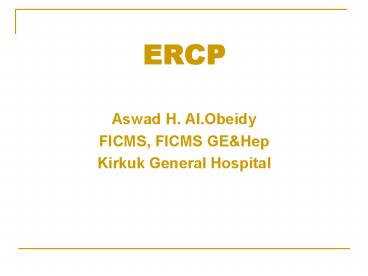ERCP - PowerPoint PPT Presentation
1 / 9
Title:
ERCP
Description:
ERCP Aswad H. Al.Obeidy FICMS, FICMS GE&Hep Kirkuk General Hospital ERCP ERCP was first described by McCune and coworkers in 1968. Patients receive sedation and ... – PowerPoint PPT presentation
Number of Views:1451
Avg rating:5.0/5.0
Title: ERCP
1
ERCP
- Aswad H. Al.Obeidy
- FICMS, FICMS GEHep
- Kirkuk General Hospital
2
ERCP
- ERCP was first described by McCune and coworkers
in 1968. - Patients receive sedation and analgesia
(conscious sedation). - The side-viewing endoscope has a viewing field
that is perpendicular to the long axis of the
instrument to permit better visualization of the
medial wall of the descending duodenum. - Various diagnostic and therapeutic duodenoscopes
with channels of different sizes are available. - Mother-daughter scopes (cholangioscopes that can
be inserted through a 4.2-mm channel of a
standard duodenoscope).
3
ERCP
- The routine use of antibiotics prior to ERCP is
controversial. - Oral antibiotic prophylaxis appears to be safe
and cost-effective in patients undergoing
therapeutic ERCP. - Adequate sedation is of the utmost importance.
- If standard sedation and analgesia are not
possible or are too dangerous, general anesthesia
must be considered. - Midazolam (a benzodiazepine) and meperidine (a
narcotic) are generally administered.
4
ERCP
- In patients with a normal anatomy, cannulation of
the papilla is usually successful. - to achieve better than a 95 success rate, a
precut papillotomy may be needed. - Neither cholangitis nor pancreatitis is a
contraindication to ERCP if a thera-peutic
maneuver is being considered. - Competence in therapeutic ERCP requires
specialized training and mentoring. - When an attempt at ERCP fails, the patient may
need to be referred to a specialized center with
a more experienced endoscopist trained in
advanced techniques. - Success rates higher than 96 with an acceptable
complication rate of 10 should be expected. - Storage of data and images is particularly
important with therapeutic procedures the
precise anatomy must be delineated for surgical
and radiologic colleagues
5
ERCP
- Patients can often be discharged home after a
therapeutic ERCP. - But those
- Who experience pain after the procedure.
- Have had pancreatitis in the past.
- Have suspected sphincter of Oddi dysfunction.
- Have cirrhosis.
- Have had a difficult cannulation or a precut
papillotomy. - Are at higher risk of a complication and should
be admitted to the hospital for observation.
6
Complications
- Infection
- Bleeding
- Pancreatitis
- Retro duodenal perforation
- Impaction of a stone or retrieval basket
- Complications of varying severity occur in 5 to
10 of endoscopic biliary interventions.
7
Post-ERCP pancreatitis
- Women.
- In patients with sphincter of Oddi dysfunction.
- In those with previous ERCP-associated
pancreatitis. - In patients in whom the pancreatic duct is filled
excessively with contrast dye. - In those in whom a precut papillotomy is
performed .
8
Late complications
- Acute cholecystitis.
- Stenosis of the papilla.
- Cholangitis.
- Retained or new CDB stones.
- Inexperience of the biliary endoscopist (lt200
cases per year). - Use of a precut papillotomy to gain access to the
bile duct are independent risk factors for major
complications.
9
ERCP difficult or impossible
- Previous surgery, such as a Billroth II
gastrojejunostomy. - Roux-en-Y choledochojejunostomy.
- Uncorrectable coagulopathy also is associated
with increased risk and may represent a
contraindication to ERCP































